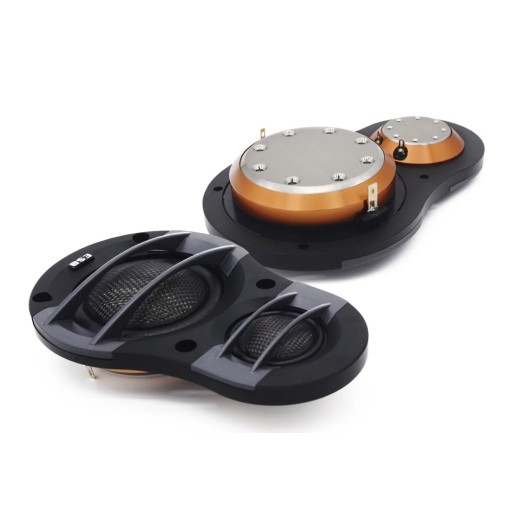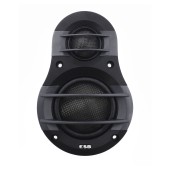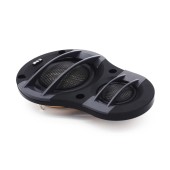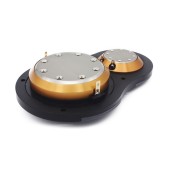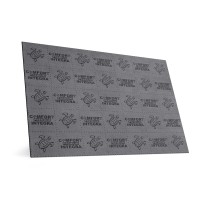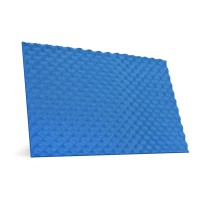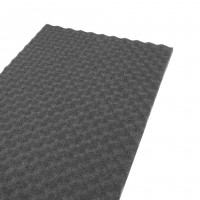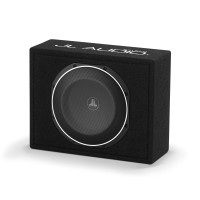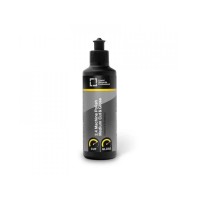Speakers ESB Audio 5.UMA
More about the product
- You can return the goods to us within 14 days
ESB Audio 5.UMA 2-way component speakers
The philosophy of the 5000 (Cinquemila) project was to create a speaker system with an extremely high dynamic response in order to reproduce sound with a more realistic presentation. To achieve this goal, it was necessary to ensure the lightness and speed of the mobile part of the speaker in its movements and their sudden changes. And this is especially true at high outputs when connected to an amplifier. This is also why exclusive materials were used for the Cinquemila series, which will enable the ESB engineer's high demands on top quality sound. It is worth noting the very rigid and light composite membrane reinforced with carbon fibers, which was used in the treble, mid-bass and in the three-way system as well as the center speakers. The ABS speaker basket was also reinforced with carbon, and noble metal parts machined on a CNC machine were also used for its production. Great attention was also paid to ventilation and powerful magnets. The result is high-end two-band and three-band systems, which will be hard to beat at the given price. A unique UMA unit is also available for the 5000 series, which includes both a tweeter and a center speaker. This special and exclusive component driver is a concept born in the 1970s and aims to concentrate the midrange and tweeters into a single virtual point. This minimizes phase lags and transition point irregularities. The speaker consists of a 28mm tweeter and a 50mm mid-range speaker with a different dust cover to have a mid-range function (not full-range) and not disturb the tweeter frequencies.
ESB Audio 3000 series tweeters and midrange speakers
The membrane of the tweeters and center speakers is made of PMC composite material, which is additionally reinforced with carbon fibers. This ensures excellent stiffness and at the same time a very low weight of the membrane. The tweeter uses a very large, vented neodymium magnet that is optimized using computer simulations (FEA) for higher efficiency and improved linearity along all voice coil deflections. The highest quality neodymium magnet reduces magnetic losses at elevated temperature and concentrates more energy in a small space. The basket of the tweeter and center speaker also impresses with its beautiful design and, by the way, its heavy weight. This is due to the use of noble metal materials, which are produced by the CNC process. Great attention has been paid to the axial and radial ventilation of the moving coil to ensure high performance handling, reduced distortion and increased life. Axial vents reduce air compression at the rear of the diaphragm with significantly reduced distortion and extended response into lower frequencies. The 28 mm aluminum voice coil for the tweeter and 50 mm for the center speaker allows the use of very high power for this type of component. Although the speaker basket excels in its anti-resonance properties, residual resonances are additionally suppressed by the dB Cloth® damping material under the dome, which extends the frequency response to the lower limits and reduces harmonic distortion.
About the ESB Audio brand
The history of ESB Audio dates back to 1972, when this Italian brand was officially founded. ESB audio is one of the most famous speaker system manufacturers of the second half of the 19th century, and during their rich history they have launched many innovative technologies and many high-end home audio products that have achieved huge worldwide success. Based on the experience gained, in 1984, ESB engineers began to engage in research aimed at optimizing sound in the automotive environment, and two years later they started the production of the first car speakers. Thanks to the great success, ESB began to focus more and more on the automotive industry and its demanding challenges. Car Audio is becoming a phenomenon of the time, and in 2005 a school focused exclusively on vehicle sound was founded in the city of Aprilia, where ESB is based. It was then that the final decision was made to leave the world of home audio and focus exclusively on vehicle sound systems. Currently, ESB belongs to the Italian company Apex Group together with the American manufacturer of audiophile amplifiers and DSP processors Zapco. In the offer you will find several model lines of speakers, led by the super high-end Diecimila three-way system, which represents probably the best quality and most expensive car speakers on the market today. And that is the main mission of ESB audio. To produce speakers of the highest quality, focused on faithful sound, which will allow the user to reproduce as the interpreter intended. Exactly according to the company's slogan "Just like live".
| Catalog number | ESB 5.UMA |
| Brand | ESB Audio |
| Links | Official web presentation (English) |
| Speaker typeCoaxial speakers: Coaxial speakers are characterized by a so-called all-in-one design. The tweeter and mid-bass speaker are in one basket. The advantage is simpler assembly, but thanks to the connection or proximity of the bands in one speaker, the sound quality will usually be reduced. As a rule, in the middle of the mid-bass speaker, there is a tweeter whose voice coil works in the second air gap of the common magnetic circuit. The three-way coaxial speaker consists of a mid-bass speaker, a center speaker and a separate tweeter in the front on a special beam. Component Speakers: Component speakers are characterized by a division into individual frequency bands, treble + mid-bass + or. bass band. The individual speakers can be placed completely separately, which results in a better sound and acoustic performance. In the vast majority of cases of component speakers, an external crossover is also supplied, which divides the treble, middle / mid-bass, and into the three-band the bass band or allows setting the decibel level of the tweeter (e.g. +2 dB, 0 dB, -2 dB), steepness (e.g. 6dB/Oct. 12dB/Oct.) or active or bi-amp connection. | 2-band |
| RMS powerRMS speaker power is the constant power of the entire system, not just one speaker or one side. This is also the performance of continuous use of the speakers. If the RMS power is exceeded for a long time, the speakers may be irreversibly damaged! | 110 W |
| Max. (maximum performancePeak performance , which the speaker can play for a moment (approx. 0.5 s), for example when hitting drums in a song. If the max power is exceeded, the speakers will usually be damaged! | 220 W |
| Sensitivity (SPL 1W/1m)Sensitivity, sensitivity or efficiency of the speaker. Speaker sensitivity is given in decibels (dB) and simply put, the higher the value, the lower the demands on the amplifier's power. This is a defacto rating of how a speaker converts watts to sound. Sensitivity ratings are in noise level measured at 1 meter from the speaker using 1 W (watt of power) or using 2.83 volts at the source at 1 meter. A higher decibel level means the speaker is louder with less power. For every 3 dB increase in sensitivity, the speaker requires half the power to reproduce the same volume. For example, if an 88 dB speaker needs 100 Watts to produce a certain volume, then a speaker with a sensitivity of 91 dB needs only 50 Watts to reach the same volume. | 91 dB |
| ImpedanceImpedance - measurement of electrical resistance. When buying speakers, it is important to make sure that the impedance matches the amplifier or car stereo you are using. Example: A 2 Ohm speaker cannot be connected to an amplifier that is only stable up to 4 Ohms! A 4 Ohm speaker can easily be used with an amplifier that is stable up to 2 Ohms. The most common speaker impedance today is 3 - 4 Ohm. | 4 Ω |
| Frequency rangeThe ability of the speakers to play a signal from the lowest frequency to the highest, or the speaker's ability to faithfully reproduce sound in a specific frequency band. Professionally: In the frequency range from 40 to 16,000 Hz, the vast majority of fundamental and overtones (harmonics) of all musical instruments are found. We are interested in the course of the radiated sound pressure in this range of frequencies when the loudspeaker system is supplied with constant power. We call this course the frequency characteristic, which tells us the level of radiated sound pressure in decibels (dB) depending on the frequency. The frequency characteristic of a speaker or speaker system can be expressed most succinctly with a graph. Mostly, however, the frequency characteristic is indicated by indicating the maximum tolerance of the sound pressure in the given frequency range, e.g. 50 to 15,000 Hz -+ 6 dB. Since the frequency characteristics of loudspeakers and systems in general are quite uneven, some manufacturers do not even specify this maximum tolerance of sound pressure in decibels in their catalogs for reasons of prestige. Data impoverished in this way is unfortunately worthless. What is valid is that the manufacturer offers a speaker system with a frequency range of 30 to 20,000 Hz, if he is worried about stating the maximum unevenness of the sound pressure in this range, because he can have a tolerance of, for example, +- 20 dB. The unevenness or undulation of the frequency curve in good speaker systems for high-quality music performance should not exceed +-3 dB in the 80 to 12,000 Hz band and +-6 dB in the 40 to 16,000 Hz band. Greater unevenness already depletes or emphasizes certain tonal areas, which can cause audible or even disturbing distortion. The proportion between fundamental tones and higher harmonics also changes, thereby changing the color of the sound, and individual musical instruments as well as the entire musical image sound unnatural. | 500 - 25000 Hz |
| Center speaker diameterThe diameter of the center speaker is given as the diameter of a round speaker, not including the mount, where the mounts protrude even more on smaller speakers. | 50 mm |
| Mounting depth of the center speakerThe mounting depth of the center speaker is measured from the bottom edge of the magnet to the bottom edge of the tin, plastic or cast speaker basket. | 17 mm |
| Center speaker diaphragm materialDiaphragm material that was used in the manufacture of the center speakers. | Composite PMC reinforced with carbon fibers |
| Overall tweeter diameterThe total diameter of the tweeter is given as the diameter of the individual tweeter without the installation houses. | 28 mm |
| The overall depth of the tweeterThe total depth of the tweeter itself without the installation houses. | 8 mm |
| Tweeter dome materialThe shell material that was used in the manufacture of the tweeter. | Composite PMC reinforced with carbon fibers |
| Frequency crossover included in the packageThe crossover is an important part of defacto all loudspeakers. A crossover usually contains different resistor values, coil sizes, and capacitor types that fundamentally modify the sound. We describe below what the turnouts are for. Component Speakers: A crossover is part of every quality component speaker system. Its task is to ensure the distribution of frequencies that the amplifier produces in the entire acoustic spectrum of frequencies so that each of the speakers receives only that part of the band that it can optimally play in terms of efficiency and minimal distortion. Coaxial speakers: In most cases, coaxial loudspeakers have a simple crossover (6dB/Oct.) formed by a capacitor at the tweeter. | No |
| Cover grids included in the packageOriginal cover grilles in speaker packaging. | Yes |
| Price forIf the price is for a pair, the package always includes 2 pieces of everything, e.g. 2x mid-bass, 2x tweeter and 2x crossover. | Few |
